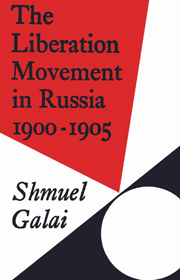Book contents
- Frontmatter
- Contents
- Dedication
- Acknowledgments
- Note on dates, etc.
- List of abbreviations
- Introduction
- Part One ORIGINS
- Part Two THE FORMATION OF THE LIBERATION MOVEMENT
- Part Three WAR AND REVOLUTION
- 9 Setback and recovery
- 10 ‘No enemies on the left’
- 11 Unleashing the Revolution
- 12 Defeat in victory
- Appendix A The origins of Beseda
- Appendix B A bibliographical note on the writings of Kuskova and Prokopovich in the years 1898–9
- Appendix C Note on sources on the formation of the Liberation Movement
- Bibliography
- Index
11 - Unleashing the Revolution
Published online by Cambridge University Press: 22 September 2009
- Frontmatter
- Contents
- Dedication
- Acknowledgments
- Note on dates, etc.
- List of abbreviations
- Introduction
- Part One ORIGINS
- Part Two THE FORMATION OF THE LIBERATION MOVEMENT
- Part Three WAR AND REVOLUTION
- 9 Setback and recovery
- 10 ‘No enemies on the left’
- 11 Unleashing the Revolution
- 12 Defeat in victory
- Appendix A The origins of Beseda
- Appendix B A bibliographical note on the writings of Kuskova and Prokopovich in the years 1898–9
- Appendix C Note on sources on the formation of the Liberation Movement
- Bibliography
- Index
Summary
The ‘Second’ Zemstvo Congress proved an even greater success than the leaders of the Union of Liberation had hoped. The protracted negotiations with Svyatopolk-Mirskiy lent it greater political importance than it would otherwise have had, and this was augmented in the eyes of the public by the last-minute decision of the Minister to prohibit any reporting of its proceedings in the legal press. (While in session it received 42 cables of support from public institutions and various groups.) Not only the friends but also the Social-Democratic opponents of the Liberation Movement regarded the congress as a political event of the first magnitude, and both friends and foes used almost identical words in describing it. Struve wrote in Osvobozhdeniye that the congress was ‘an event of paramount historical importance’, and he was echoed by the editors of Iskra, who wrote in a leading article on ‘The Results of the Zemstvo Parliament’, that ‘the decisions of the Zemstvo Congress have acquired the significance of a political event of paramount importance’.
The success of the congress enabled the Council to tackle without delay the two tactical points decided on at the Union of Liberation's Second Congress, namely the launching of the ‘banquet campaign’ and the establishment of intelligentsia unions. By so doing the Council put into motion the political events of November 1904 – December 1905, commonly known as the ‘First Russian Revolution’.
- Type
- Chapter
- Information
- The Liberation Movement in Russia 1900–1905 , pp. 232 - 250Publisher: Cambridge University PressPrint publication year: 1973

